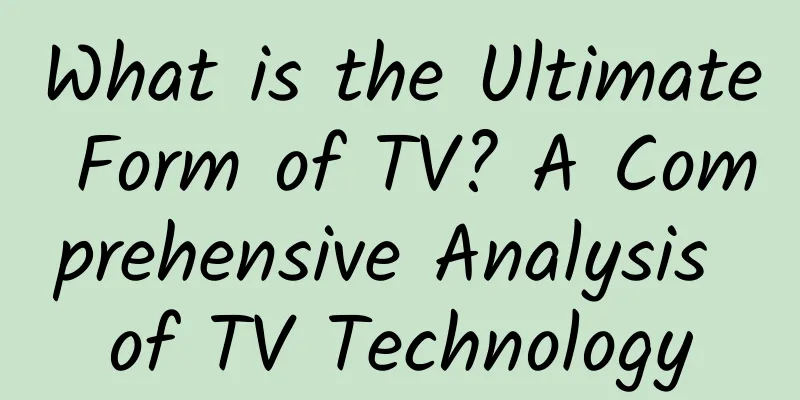What is the Ultimate Form of TV? A Comprehensive Analysis of TV Technology

|
For many people, 1080P once represented high-quality images, but with the continuous evolution of TV technology, the emergence of 2K and 4K has once again brought the picture to the pinnacle of visual effects. At present, the TV market is highly competitive, and different TV technologies are also flourishing. But what kind of technology is needed for future TVs? Today, follow the author's footsteps to learn more about it. 4K Ultra HD resolution For many consumers, the concept of 4K is no longer unfamiliar. With its popularity in recent years, 4K TVs have begun to enter more and more homes. We once thought that 1080P, which had sufficient clarity, had a resolution of only one-fourth of 4K. 4K resolution is a pixel resolution of 4096*2160. In terms of the number of pixels, it is twice that of 2K and four times that of 1080P. The increase in pixels allows the details of the picture to be fully displayed, even small textures. Not only does the clarity of the picture rise sharply, but the frame rate at 4K resolution has also been improved to a certain extent, which means that when we watch the picture, the movement and switching of the picture will be smoother and more comfortable, which is also an enhancement to the viewing experience. The current penetration rate of 4K TVs has exceeded 50%, and they have truly entered the homes of consumers. Compared with the previous clearer and smoother pictures, 4K's excellent picture quality has been widely recognized. In the process of popularization, 4K is also constantly overcoming problems such as the lack of film sources, slow network speed, and unsupported interfaces. But is 4K the limit of what the human eye can see? The author believes that it is too early to define 4K as the limit of vision, and consumer demand is also calling for clearer products. HDR High Dynamic Range Image Although HDR has existed for more than ten years, its application in television has attracted the attention of many people. HDR refers to high dynamic range images, and the real HDR is to effectively convert light signals into electrical signals through the photoelectric conversion mechanism. In the conversion process, HDR has a wider dynamic adjustable range. Therefore, we can see the picture effects with higher brightness, richer details, and better color depth under HDR technology. TVs equipped with HDR technology can significantly improve the brightness of the picture, make the details of bright and dark areas more refined, the contrast between light and dark is more obvious, and the layering of the picture is enhanced. With the increase in brightness, the color space texture of the picture is also enhanced. After the birth of HDR technology, there was a period of time when no new standards were established, so the old standards of SDR technology were still used. In order to improve the picture quality of SDR, some manufacturers have also begun to develop picture quality enhancement technology. Among them, Sharp TV's brilliant color technology is "formed" by imitating HDR technology. Brilliant color technology can adjust the backlight brightness of corresponding parts according to the light and dark information of different parts of the picture, making the dark colors deeper and the bright colors purer. In Sharp's new brilliant color technology, intelligent analysis of light sources and reflective light sources in the image is added, with a stronger picture quality adjustment system. Wide color gamut For some consumers, the concept of wide color gamut may be unfamiliar. In fact, it is easy to see from the name that this technology focuses on the color of the picture. When choosing a TV, you can see words like "NTSC92%". In fact, this is the color gamut coverage of the TV. A TV with a color gamut coverage of NTSC92% or above can be called a wide color gamut TV. The color gamut determines whether the color of the picture is bright and whether it is close to the real world. Wide color gamut is a color backlight technology, which is mainly improved in two ways: light source and filter. Depending on the type of TV, wide color gamut can be perfectly applied to LED, QLED, and OLED TVs. The cost of wide color gamut technology is not too high, so the scope of application is relatively wide, and it is displayed in various brands. In addition, there are many voices saying that wide color gamut does not play a big role in improving picture quality. In fact, under the effect of wide color gamut technology, the increase in colors makes the transition between each color more natural and makes the colors purer. If you want to understand the actual experience of wide color gamut, it is better to go to the store and experience it yourself. 8K resolution On August 31, Sharp officially released the world's first consumer-grade 8K TV. The 70-inch screen is four times better than 4K resolution, which shocked industry insiders. Although we are very familiar with 2K and 4K, we are still unfamiliar with 8K. 8K resolution has 7680*4320 pixels, which is about 33 million pixels per frame. This data is 4 times the resolution of 4K and 16 times that of 1080P. It can be said that it has reached the limit of human eye viewing. What 8K brings to us is not just a further enhancement of resolution. NHK's encoding requirements for 8K TVs require that the frame rate must reach 120 frames per second. This means that every frame in the TV screen will "fill" 120 frames. In addition to factors such as picture quality and resolution, the number of frames also has a certain impact on our immersion and sense of involvement, and 120 frames is currently the effect closest to the human eye. Ang Lee's "Billy Lynn's Long Halftime Walk" allowed many people to experience the movie-watching experience at a high frame rate, and now, the ultra-high immersive feeling of 4K 120 frame rate also has the opportunity to enter our homes. Some consumers also think that 4K has not yet been fully popularized, and whether the arrival of 8K is too early. In fact, at the beginning of 4K, we also doubted whether 4K was necessary to promote it, and the lack of upstream resources and video content also made the popularization of 4K difficult. But now consumers' requirements for picture quality are still increasing, which has further promoted the arrival of 8K technology. When it comes to 8K, you have to know the "Father of 8K" - Sharp. As a veteran TV manufacturer, Sharp enjoys the title of "Father of LCD". In terms of TV technology, Sharp is proficient in all kinds of skills, whether it is the ultra-cutting-edge technology 8K, or the HDR and wide color gamut technologies that are now widely used, and the "unique secrets" developed - the new brilliant color technology, Sharp has relied on years of technical accumulation, combined with the core needs of consumers, to finally create a TV product close to the future. In addition to excellent "soft power", Sharp's LCD panels are also well-known. The TV panel is actually a very sophisticated component. When manufacturing the "Sharp screen", nano-level ultra-fine processing technology is also used to give people a stunning picture quality that "brightens the eyes". There is no doubt that Sharp TV, which has multiple technical blessings and strong hard power support, will tell us what the future TV will look like. As a winner of Toutiao's Qingyun Plan and Baijiahao's Bai+ Plan, the 2019 Baidu Digital Author of the Year, the Baijiahao's Most Popular Author in the Technology Field, the 2019 Sogou Technology and Culture Author, and the 2021 Baijiahao Quarterly Influential Creator, he has won many awards, including the 2013 Sohu Best Industry Media Person, the 2015 China New Media Entrepreneurship Competition Beijing Third Place, the 2015 Guangmang Experience Award, the 2015 China New Media Entrepreneurship Competition Finals Third Place, and the 2018 Baidu Dynamic Annual Powerful Celebrity. |
Recommend
CINNO: China's investment in new energy industry will exceed 5 trillion yuan in 2022, a year-on-year increase of more than 240%
According to data from CINNO Research's "...
Daguang Kakaka's crazy cash-in class, five Douyin silent money-making tracks, nanny-level teaching
Daguang Kakaka's Crazy Cash-in Course, Five D...
Only sticks to pests, not beneficial insects? Magic slime made by plants!
Popular Science Times (Intern Wang Yuke) Sticky t...
What are the functions of Zhangye WeChat Beauty Mini Program? How much does it cost to develop a skin care product mini program?
The most profitable industry nowadays is the &quo...
Your app has no users mainly because of the following reasons...
[[144037]] Recently, I have been in contact with ...
End of an era: McLaren boss Dennis forced to step down
Ron Dennis has officially stepped down as chairma...
How to create a high-conversion enterprise-level TikTok account?
In fact, when most people choose promotion channe...
Subvert your cognition! To prevent Alzheimer's disease, you may only need one shot of vaccine? !
As the aging process of the population accelerate...
Xiaohongshu is in a dilemma, and Mao Wenchao doesn't have much time left
1 E-commerce "hunting" Xiaohongshu A hi...
Mobile video live streaming is on the rise: ideals are great, but reality is still tough
In the past few months, Huajiao, Inke, Yizhibo an...
How much does it cost to produce the Tianshui Printing mini program?
In order to better penetrate into various industr...
Do Java arrays have to be initialized before they can be used?
An array is a composite structure provided by mos...
The "Tianhui Medical Book" that reappeared more than 2,000 years ago turned out to be the lost medical book of Bian Que?
Recently, the Tianhui Medical Bamboo Slips, a Han...
Where can I open the Douyin live broadcast console? What are the functions?
Just like Taobao Live has a Taobao Live console, ...
Smart eating in winter - are the nuts you eat carbohydrates or fats?
Nuts can be said to be the protagonists of the wi...









